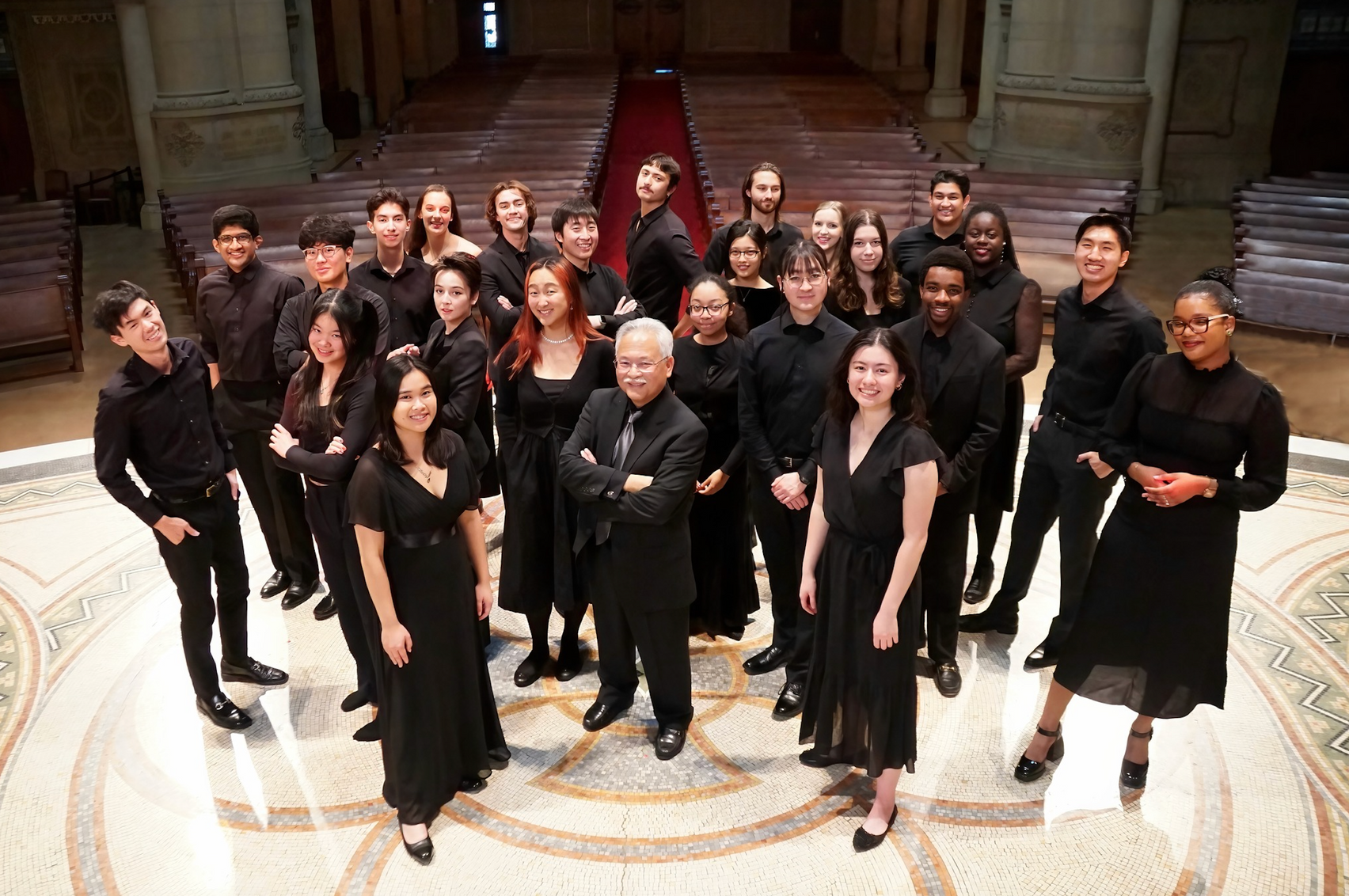
MUSIC 220C Final Project
Zoe Quake
Project Overview & Motivation
This is my second year singing in the Stanford Chamber Chorale, and before college, I sang with Cantabile Youth Singers for 10 years. For this term-long research project, I knew that I wanted to investigate some question related to choral music and performance. A special part of Chorale is the callback rehearsal, where Steve invites auditionees to sing with the current members of Chorale to learn more about the interactions between specific singers’ voices. While this is a long process, it is a critical one, as even the act of switching the placement of two singers in a section can have a profound effect on the sound they produce. This has always been an aspect of Chorale that has long fascinated me and others in the group, and inspired me to start wondering about other ways singer placement can manipulate the overall sound of a group. Hence, I decided that, for this project, I would like to explore how singer placement can be used as a compositional tool to affect audience performance experiences.
Project Description
To start answering my research question, I decided that it would make the most sense to take an already-existing piece of repertoire in Chamber Chorale’s spring repertoire and make some compositional changes myself with altered singer placement in mind rather than composing my own choral arrangement from scratch. I considered the pieces in the spring rep that might have the potential to be musically compelling after some reconfiguring, and ideated with three pieces for a while before deciding on Soli Deo Gloria by Lavinia Kell Parker. In addition to exploring how singer placement can be used as a compositional tool, I also wanted to experiment with different methods of modeling and simulation as a means to answer my research question. To achieve both of these ends, three different methods of comparison were utilized to investigate differences in audience perception (further outlined in project deliverables page below).
Project Deliverables
There are three different methods that were used for comparing the normal singer placement and composition to the experimental version. Firstly, there is an option to listen to the recordings from the ambisonic mic to demonstrate physical acoustics (for best results, compare in listening room) which demonstrates the effects of physical reverb on the acoustics of the singer placement. Secondly, there is an option to listen to an acoustic measurement-enabled method of comparing the acoustic effects (see REAPER files for result; see Week 10 for more methodology information). Lastly, there is an option to listen to the simulated acoustics using the plug-in I made using Braudio and the recordings from the three smaller mics (use listening room if possible). The links to all the audio files and project files are attached below:
Week 3
- In week 3 I met the class! I learned more about cool stuff that students can do at CCRMA, and was super pumped at the end of the first class I attended.
- Throughout the week, I brainstormed a couple different project topics that I thought would be interesting to take on for a quarter. Among them were experimenting with singer placement as well as data sonification in clinical settings. Chris and I talked through my ideas, as well as what they could feasibly entail in a quarter-long project.
Week 4
- In week 4, I finalized my project topic! I decided on exploring how singer placement can be utilized as a compositional tool to affect audience perceptions and experiences.
- I started researching to learn more background on the topic and to get a sense of what kind of work has already been done in this area.
- I found a fantastic honors thesis (linked here) by John Guzik, a Schulich School of Music graduate, that provided excellent supplementary reading for the week in addition to the research I was doing.
- I also considered what kind of scope I would like to take on for this project when considering time and resource limitations; I also considered what level of collaboration with the Chamber Chorale would be feasible given the rehearsal and performance schedule of the group.
- Lastly, I went to Los Angeles Master Chamber Chorale performance at Bing Concert Hall entitled “Music to Accompany a Departure”, which was an artistic collaboration between Peter Sellars, Grant Gershon, and singers of the Los Angeles Master Chorale to produce a performance of Heinrich Schütz’s Musikalische Exequien infused with movement, a unique depth of emotion, and a collective exploration of loss, grief, and love not long after the heels of the height of COVID-19. Not only was this a transformative performance to see, but it was quite a successful example of how singer placement (and in this case, choreography) can impact audience experience through symbolism. However, it was also personally interesting to see the acoustic effect of constantly moving and shifting singers, both on the stage but also in other areas of the concert hall.
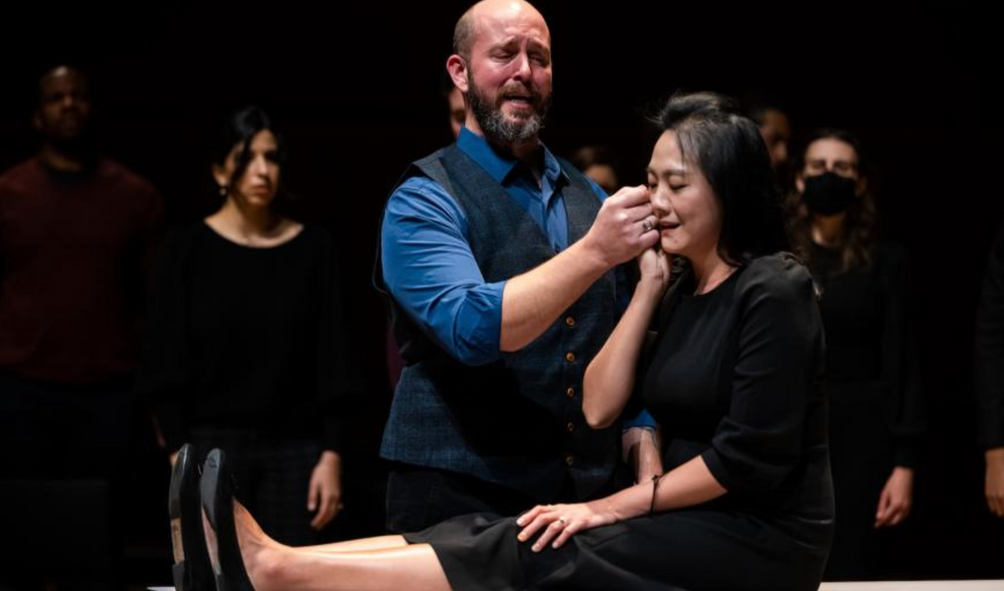
Los Angeles Master Chorale in Music to Accompany a Departure | Credit: Brian Feinzimer
Los Angeles Master Chorale in Music to Accompany a Departure | Credit: Brian Feinzimer
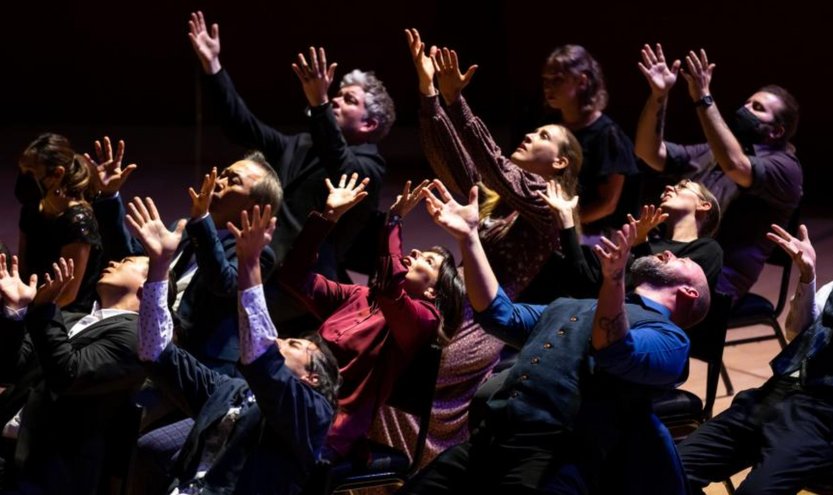
Week 5
- During week 5, I met with Luna outside of class for a comprehensive introduction to the listening room. I learned the basics of how to work with the hardware, the key pieces of software I would need for my project, and we spent time practicing how to troubleshoot (Luna would mess with the settings, I would try to calibrate, repeat!)
- I also started considering potential pieces from the spring Chorale repertoire; I considered what musical motifs might be fun to play with or tease out in addition to what songs might have interesting new effects when changing singer configurations.
- I narrowed it down to three potential pieces, and started sketching out potential ways to manipulate singer placement and thinking through what kind of effect I thought it would create. I ended up choosing Soli Deo Gloria by Lavinia Kell Parker (pictured below).

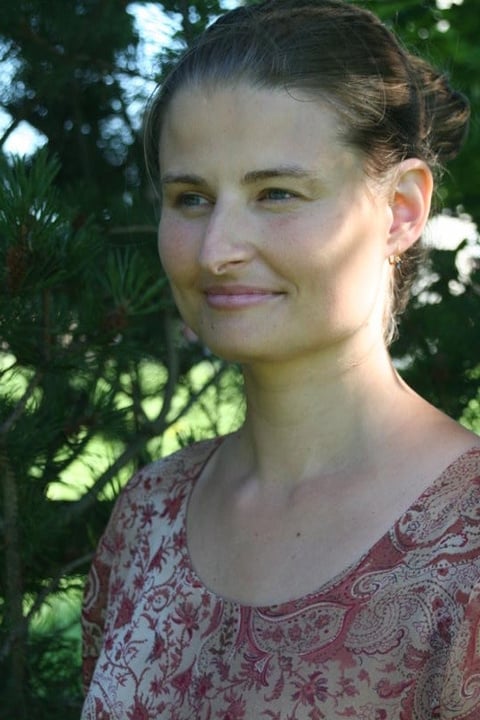
Week 6
- Unfortunately, I was sick in week 6 and was mostly just resting :(
Week 7
- In week 7, I continued researching on my own to add to my understanding of different ways that individuals have already experimented with alternative singer placements.
- In addition to continuing background research, this week, I really focused on the compositional changes I wanted to make to the score of Soli Deo Gloria, and how I wanted to change singer placements. I ended up choosing to focus on modifying a section in the middle that has a rocking motif in the upper voices, in part inspired by the two-choir configuration of Franz Biebl’s Ave Maria. Some of my work is pictured below:
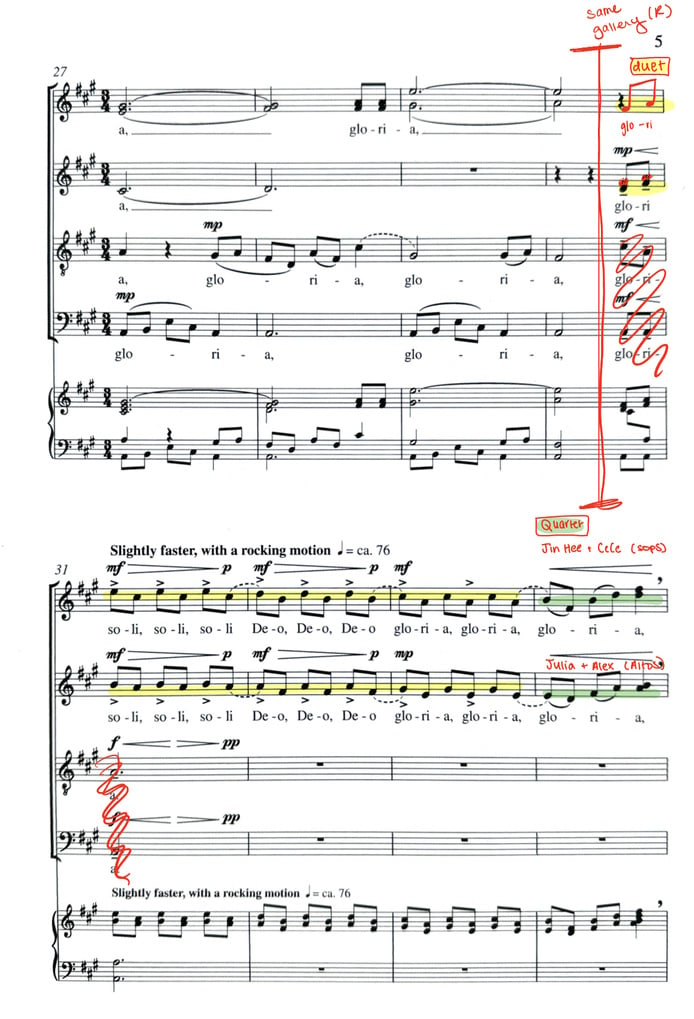

Week 8
- During week 8, Luna very kindly gave me a crash course in recording, editing software, and best practices, including how to synchronize recordings from different mics.
- This was week was a significant logistical push to try to be totally set to go by the recording session next week with Chamber Chorale. In addition to Luna’s crash course, I also learned from Chris, Luna, and the rest of the 200C class what types of microphones would be best to use and some of their limitations. I checked out and learned how to use all relevant equipment and ordered supplementary supplies, including backup batteries and balloons to take impulse reaction measurements in MemChu.
- This is the mic type and placement that was decided on (roughly):
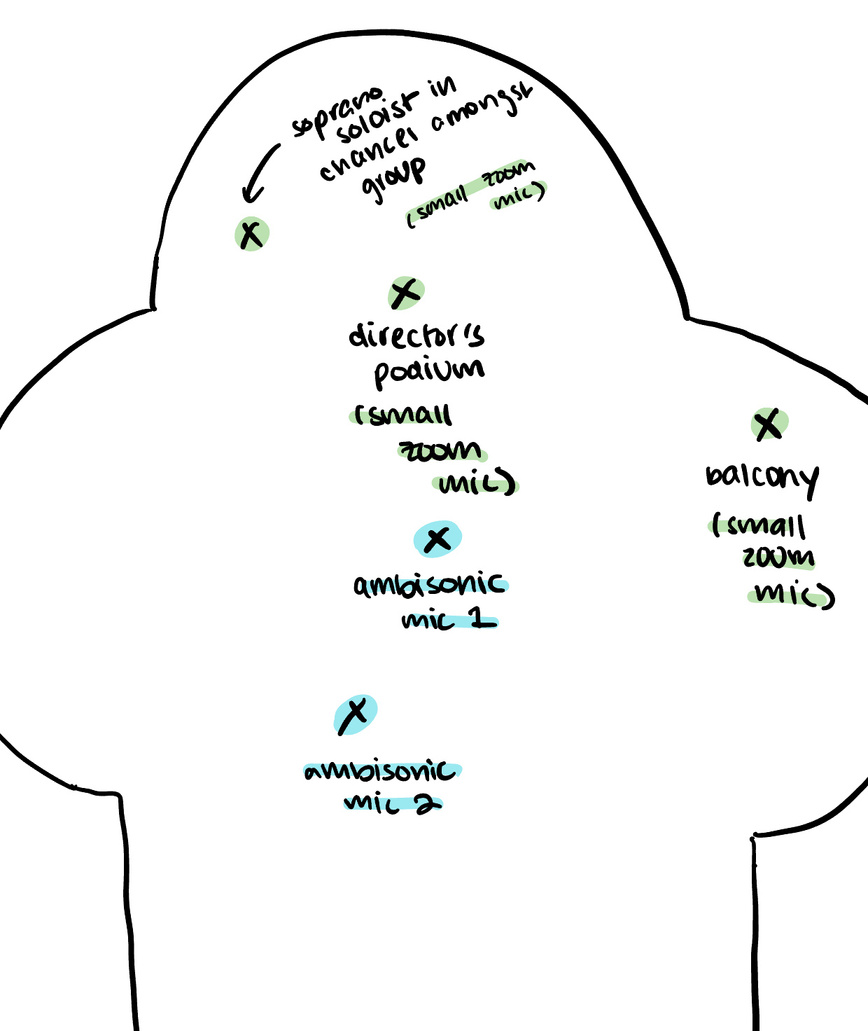
Week 9
- During week 9, I consulted with Chris and Steve to receive any last guiding thoughts before the recording session that upcoming Thursday.
- On Thursday post-dress rehearsal in MemChu, I talked through the changes to Parker I wanted to make, Luna and I set up the mics as Steve rehearsed once through with Chorale and the quartet in the balcony to allow singers to become accustomed to listening and adjusting differently, and then we did two takes of the experimental version and one take of the normal version of the piece.
- After Chorale finished recording, Luna and I took acoustic measurements through popping ballons in the different spots that the smaller zoom mics were stationed in order to create impulse response recordings that could be used for the measurement-based method outlined above.
- Then, over the weekend, I started analyzing the ambisonic recordings in listening room.
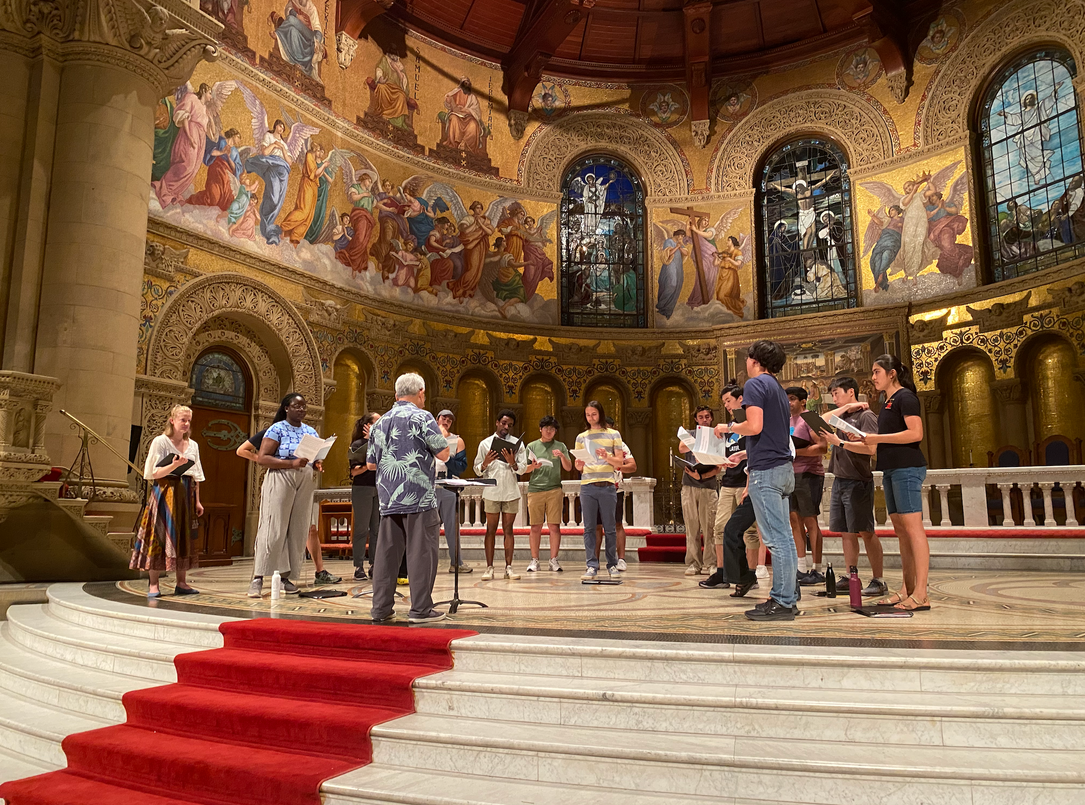
Recording session with Stanford Chamber Chorale and director, Steve Sano
Week 10
- During week 10, I edited the takes from the ambisonic mics and previewed the results in the listening room. I also edited all the takes from the small zoom mics in REAPER (see setup below), aligned the recordings in a way that synchronized them, applied the effects from the impulse reaction recordings, and adjusted the settings to create two cohesive recordings of the normal vs experimental versions of Parker. Lastly, I uploaded the newly edited zoom mic recordings to the Listening Room Macbook so I could use them with my plug-in to finish the simulated method of comparison.
- Then, I finalized my website, presented my findings, and reflected on the results of the project (see next page).
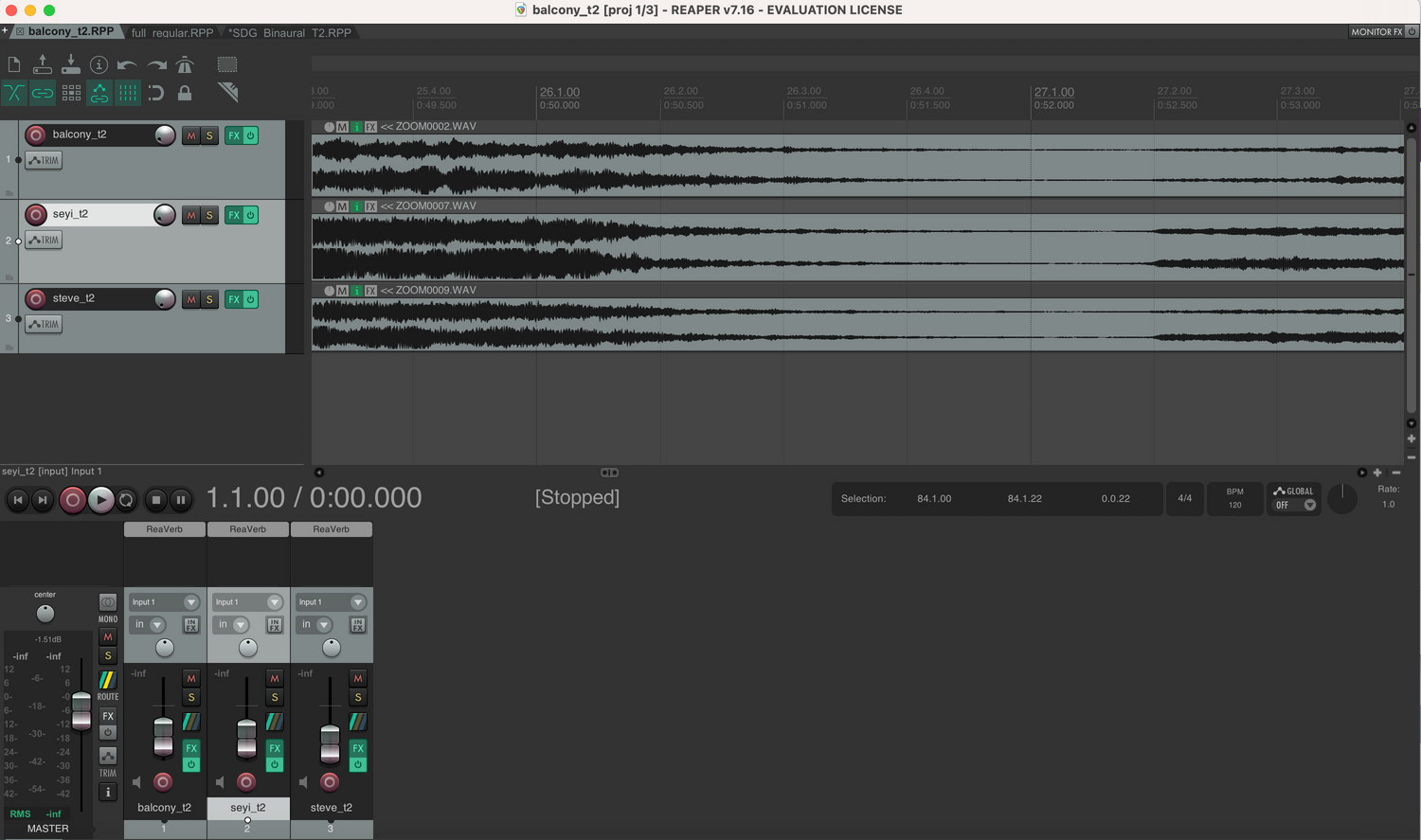
Reflections and Next Steps
- Overall, I think that the ambisonic mic recordings were most helpful to compare the two different singer configurations and resulting acoustic effect. The measurement-enabled acoustic simulation and the model/plug-in provided useful yet somewhat incomplete data on how the changes of singer placements ended up sounding like in person.
- While I do think that separating out a quartet of singers for the middle rocking motif is musically compelling, I don’t think I would continue with the current experimental configuration. Having the quartet singing from the balcony provides an interesting separation, but since the quartet is closer to the audience than the rest of the choir, it ended up sounding more overpowering than I would have liked. The regular configuration provides a very cohesive audience experience, where each of the voices feel enmeshed in each other, contributing to a sound that seemingly surrounds the audience.
- Some next steps that I think would be interesting is trying a different configuration with the current piece where the quartet is further away from the audience than the rest of the choir. I would also love to tinker with other choral arrangements to test out other configurations of singers and observe how the resulting sound changes.
Acknowledgements
This project would not have been possible without the guidance, help, and time of many other individuals. I want to extend my gratitude to Chris and Steve, who both advised me throughout the term and offered invaluable feedback on various steps of the project. Additionally, I want to thank Luna for all the time she spent training me in the Listening Room, teaching me how to use all the softwares and equipment presented in this project, and for helping me run the recording session. I am so grateful to the members of Chamber Chorale who volunteered their time after a three hour dress rehearsal to help make my vision for this project come to life. And last but not least, thank you to the other students in 220C who have offered their attention and input on this project throughout the quarter.